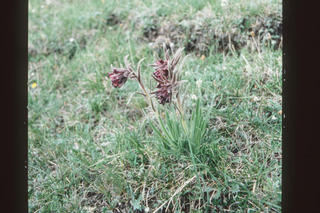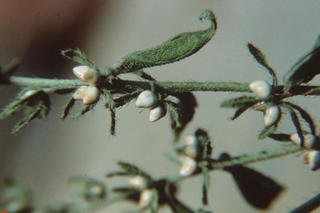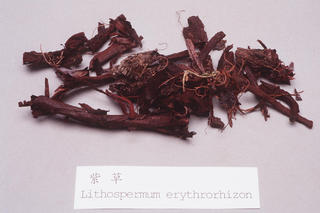Arnebia guttata
Contents
Nomenclature
Other Names:
Historical Use of Arnebia guttata
Arnebia guttata in Traditional Chinese Medicine
Background
Zicaogen ×ϲݸù
Chinese Name (pinyin): Zicao
Chinese Name :
Common Name :Arnebia or Lithoesperm Root
Specific Name : Radix arnebiae
Scientific Name:
Collection : The drug is collected in spring and autumn, removed from soil and dried.
Description : Root of Lithospermum erythrorhizon: Conical, twisted and branched, 7 - 14 cm long, 1 - 2cm in diameter. Externally purplish red or purplish black, rough with longitudinal striations, bark thin, easily exfoliated. Texture hard and fragile, easily broken, fracture, bark dark purple, wood relatively large, greyish yellow.
Identification : 1.Heat 0.5 g of the powder in a test tube, a red gas is produced and a reddish brown oil drops are condensed on the wall of the test tube.2.Macerate 0.5 g of the powder in 5 ml of ethanol, combine the washing with the filtrate. Concentrate to 1 ml as the test solution. Dissolve L-shikonin CRS in ethanol to produce a solution containing 0.5 mg per ml as the reference solution. Carry out the method for thin layer chromatography (Appendix Vl B), using silica gel G containing carboxymethyl cellulose as the coating substance and toluene-ethyl acetate-fromic acid (5:1:0.1) as the mobile phase. Apply separately to the plate 4 µl of each of the two solutions. After developing and removal of the plate, dry it in the air. The purplish red in the chromatogram obtained with the test solution correspond in position and colour to the spot in the chromatogram obtained with the reference solution. Spray with 10% solution of potassium hydroxide in methanol, the spot turns to blue. Assay: Weigh accurately about 0.5 g of the powder (through No.3 sieve), previously dried at 50ºC for three hours., to a 100 ml volumetric flask add ethanol to volume, shake constantly for 4 hours, filter. Discard the initial filtrate. Measure accurately 5 ml of the successive filtrate to a 25 ml volumetric flask, dilute with ethanol to volume and mix well. Carry out the method for specrophotometry (appendix V B), measure the absorbance at 516 nm. Calculate the content of L-shikonin (C16H16O5) taking 242 as the value of A (1%, 1cm). It contains not less than 0.80% of total pigments of Hydroxynaphthaquinone, calculated as L-shikonin (C16H16O5).
Processing : Eliminate foreign matter, cut into thick slices or sections.Radix Lithospermi and Radix Arnebia Gutatae: Eliminate foreign matter, wash clean, soften thoroughly, cut into thin slices and dry.Radix Arnebiae Processed: Occurring in irregular cylindrical section or slat shaped slices, 1 - 2.5 cm in diameter, purplish red or purplish brown. Bark dark purple, wood in cylindrical sections relatively small, yellowish white or yellow.Radix Lithospermi Processed: Occurring in irregular cylindrical sections, 1 - 2 cm in diameter, purplish red or purplish black. Bark dark purple. Texture hard, wood relatively large greyish yellow.
Action : To remove heat from blood, to promote blood circulation, to counteract toxicity, and to facilitate eruption.
Indication : purpura dark in color due to presence of exuberant toxic heat in the blood; measles with inadequate eruption; sores; eczemas; scalds and burns
Precautions :
Dosage : 4.5 to 9 g; for external use, appropriate quantity to be stewed into soft extract or soaked in vegetable oil and applied topically.
Storage : Preserve in a dry place.
Synonymns for Arnebia guttata
Patent Medicines and Medicines with Multiple Ingredients that include Arnebia guttata
Pharmaceutical Information
Chemical Constituents
Evidence or the Use of Arnebia guttata in the Treatment of Epilepesy
Basic Science
Animal Studies
Cohort, Case-Control and Non-Randomized Trials
Randomized Controlled Trials
Meta-Analysis
1st Five Results: pubmed search
Ke Zan, Zhao Wang, Xiao-Wen Hu, Yao-Lei Li, Ying Wang, Hong-Yu Jin, Tian-Tian Zuo, Shuang-Cheng Ma
Pyrrolizidine alkaloids and health risk of three Boraginaceae used in TCM.
Front Pharmacol: 2023, 14;1075010
[PubMed:37033649]
[WorldCat.org]
[DOI]
(P e)
Yu-Mei Yan, Lin-Jun Zou, Min-Hui Li, Zhao-Cui Sun, Min Zhang, Xu-Dong Xu, Chun-Hong Zhang
##Title##
Nat Prod Res: 2023, 37(17);2817-2823
[PubMed:36268558]
[WorldCat.org]
[DOI]
(I p)
Jiahui Sun, Sheng Wang, Yiheng Wang, Ruishan Wang, Kangjia Liu, Enze Li, Ping Qiao, Linyuan Shi, Wenpan Dong, Luqi Huang, Lanping Guo
##Title##
Front Plant Sci: 2022, 13;920826
[PubMed:35755641]
[WorldCat.org]
[DOI]
(P e)
Zefeng Wang, Qianfei Cui, Ling Shi, Meiling Zhang, Peng Song, Dongzhu Duan, Wenjing Guo
Network Pharmacology-based Prediction and Verification of Shikonin for Treating Colorectal Cancer.
Recent Pat Anticancer Drug Discov: 2022, 17(3);297-311
[PubMed:34951580]
[WorldCat.org]
[DOI]
(I p)
Haiyan Xu, Ping Li, Guangxi Ren, Yanjiao Wang, Dan Jiang, Chunsheng Liu
##Title##
Front Pharmacol: 2021, 12;677014
[PubMed:34276367]
[WorldCat.org]
[DOI]
(P e)


